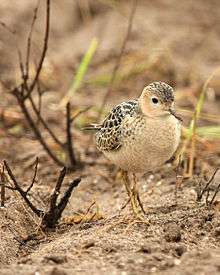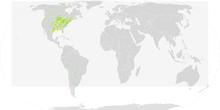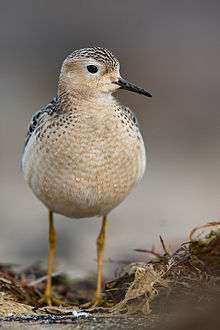Buff-breasted sandpiper
| Buff-breasted sandpiper | |
|---|---|
 | |
| Scientific classification | |
| Kingdom: | Animalia |
| Phylum: | Chordata |
| Class: | Aves |
| Order: | Charadriiformes |
| Family: | Scolopacidae |
| Genus: | Tryngites (disputed) Cabanis, 1857 |
| Species: | T. subruficollis |
| Binomial name | |
| Tryngites subruficollis (Vieillot, 1819) | |
 | |
| Range of T. subruficollis Year-Round Range Summer Range Winter Range | |
The buff-breasted sandpiper (Tryngites subruficollis) is a small shorebird. Tryngites is from Ancient Greek trungas, a white-rumped wading bird mentioned by Aristotle but not further identified. The species name subruficollis is from Latin sub, "near to" and collum, "neck".[2] It is a calidrid sandpiper and currently considered to be the only member of the genus Tryngites. It may belong in the genus Calidris itself, or more precisely with the small species thereof that could possibly be split into a distinct genus. Depending on whether this would include the curlew sandpiper or not, the name Erolia would or would not, respectively, apply.[3]
Description
This species is brown above, and has a buff face and underparts in all plumages. It has a short bill and yellow legs. Males are larger than females. Juveniles resemble the adults, but may be paler on the rear underparts.
| Standard Measurements[4][5] | |
|---|---|
| length | 190–230 mm (7.5–8.9 in) |
| weight | 63 g (2.2 oz) |
| wingspan | 460 mm (18 in) |
| wing | 128.2–138.7 mm (5.05–5.46 in) |
| tail | 56.8–61.4 mm (2.24–2.42 in) |
| culmen | 19.9–21.3 mm (0.78–0.84 in) |
| tarsus | 31.8–34 mm (1.25–1.34 in) |
Distribution and habitat

T. subruficollis breeds in the open arctic tundra of North America and is a very long-distance migrant, spending the non-breeding season mainly in South America, especially Argentina.
It migrates mainly through central North America, and is uncommon on the coasts. It occurs as a regular wanderer to western Europe, and is not classed as rare in Great Britain or Ireland, where small flocks have occurred. Only the pectoral sandpiper is a more common American shorebird visitor to Europe.
This species nests on the ground, laying four eggs. The male has a display which includes raising the wings to display the white undersides, which is also given on migration, sometimes when no other buff-breasted sandpipers are present. Outside the breeding season, this bird is normally found on short-grass habitats such as airfields or golf-courses, rather than near water.
These birds pick up food by sight, mainly eating insects and other invertebrates. The buff-breasted sandpipers are known to predate on Bombus polaris, a species of honeybee found within the Arctic Circle.[6] They will either eat the bees or feed them to their young.[6] They are often very tame.
Buff-breasted sandpipers are suspected to have hybridized with the white-rumped or Baird's sandpiper.
In South Asia and Australia
This species has been sighted in South Asia on at least three occasions. It is believed that instead of going to Argentina, this bird might have been wind-blown from the Great Plains Flyway of North America and landed up in South Asia. In November 2011, this species was sighted near Kannur, Kerala in South India.[7] The buff-breasted sandpiper has also been recorded from Australia on at least eight occasions.[8]
In 1978, Phillips recorded the species from Sri Lanka, and after that very few sightings were recorded.[9]
References
- ↑ BirdLife International (2012). "Tryngites subruficollis". IUCN Red List of Threatened Species. Version 2013.2. International Union for Conservation of Nature. Retrieved 26 November 2013.
- ↑ Jobling, James A (2010). The Helm Dictionary of Scientific Bird Names. London: Christopher Helm. pp. 372, 391. ISBN 978-1-4081-2501-4.
- ↑ Thomas, Gavin H.; Wills, Matthew A.; Székely, Tamás (2004). "A supertree approach to shorebird phylogeny". BMC Evolutionary Biology. 4: 28. doi:10.1186/1471-2148-4-28. PMC 515296
 . PMID 15329156. Supplementary Material
. PMID 15329156. Supplementary Material - ↑ Godfrey, W. Earl (1966). The Birds of Canada. Ottawa: National Museum of Canada. p. 161.
- ↑ Sibley, David Allen (2000). The Sibley Guide to Birds. New York: Knopf. p. 192. ISBN 0-679-45122-6.
- 1 2 Statman-Weil, Zoe; Wojcik, Vicki. "The Arctic Bumblebee". www.fs.fed.us. USDA. Retrieved 6 November 2015.
- ↑ Thomas, Jayan (26 November 2011). "North American Sandpiper in Kerala". migrantwatch.in.
- ↑ "Decisions reached by BARC (The BirdLife Australia Rarities Committee)".
- ↑ Rajeevan, P. C.; Thomas, Jayan. "Buff-breasted Sandpiper Tryngites subruficollis from northern Kerala : a third record for India" (PDF). Indian Birds.
External links
| Wikimedia Commons has media related to Tryngites subruficollis. |
| Wikispecies has information related to: Tryngites subruficollis |
- BirdLife species factsheet for Tryngites subruficollis
- "Tryngites subruficollis". Avibase.

- "Buff-breasted sandpiper media". Internet Bird Collection.
- Buff-breasted sandpiper photo gallery at VIREO (Drexel University)
- Interactive range map of Tryngites subruficollis at IUCN Red List maps
- Buff-breasted sandpiper Species Account – Cornell Lab of Ornithology
- Buff-breasted sandpiper - Tryngites subruficollis - USGS Patuxent Bird Identification InfoCenter
- Audio recordings of Buff-breasted sandpiper on Xeno-canto.
- Tryngites subruficollis in the Flickr: Field Guide Birds of the World
- Buff-breasted sandpiper media at ARKive

